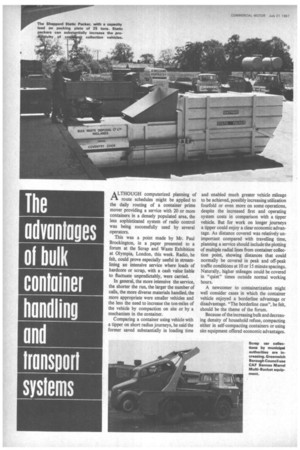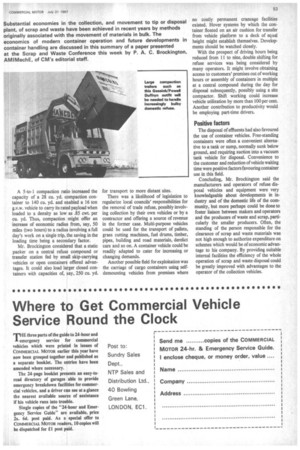A LTHOUGH computerized planning of route schedules might be applied to
Page 62

Page 63

If you've noticed an error in this article please click here to report it so we can fix it.
the daily routing of a container prime mover providing a service with 20 or more containers in a densely populated area, the less sophisticated system of radio control was being successfully used by several operators.
This was a point made by Mr. Paul Brockington, in a paper presented to a forum at the Scrap and Waste Exhibition at Olympia, London, this week. Radio, he felt, could prove especially useful in streamlining an intensive service where loads of hardcore or scrap, with a cash value liable to fluctuate unpredictably, were carried.
In general, the more intensive the service, the shorter the run, the larger the number of calls, the more diverse materials handled, the more appropriate were smaller vehicles and the less the need to increase the ton-miles of the vehicle by compaction on site or by a mechanism in the container.
Comparing a container using vehicle with a tipper on short radius journeys, he said the former saved substantially in loading time
and enabled much greater vehicle mileage to be achieved, possibly increasing utilization fourfold or even more on some operations, despite the increased first and operating system costs in comparison with a tipper vehicle. But for work on longer journeys a tipper could enjoy a clear economic advantage. As distance covered was relatively unimportant compared with travelling time, planning a service should include the plotting of multiple radial lines from container collection point, showing distances that could normally be covered in peak and off-peak traffic conditions at 10 or 15 minute spacings. Naturally, higher mileages could be covered in "quiet" times outside normal working hours.
A newcomer to containerization might well consider cases in which the container vehicle enjoyed a borderline advantage or disadvantage. "The borderline case", he felt, should be the theme of the forum.
Because of the increasing bulk and decreasing density of household refuse, compacting either in self-compacting containers or using site equipment offered economic advantages. A 5-to-1 compaction ratio increased the capacity of a 28 cu. yd. compaction container to 140 cu. yd. and enabled a 16 ton g.v.w. vehicle to carry its rated payload when loaded to a density as low as .85 cwt. per cu. yd. Thus, compaction might offer an increase of economic radius from, say, 50 miles (two hours) to a radius involving a full day's work on a single trip, the saving in the loading time being a secondary factor.
Mr. Brockington considered that a static packer on a central refuse compound or transfer station fed by small skip-carrying vehicles or open containers offered advantages. It could also load larger closed containers with capacities of, say, 250 cu. yd. for transport to more distant sites.
There was a likelihood of legislation to regularize local councils' responsibilities for the removal of trade refuse, possibly involving collection by their own vehicles or by a contractor and offering a source of revenue in the former case. Multi-purpose vehicles could be used for the transport of pallets, grass cutting machines, fuel drums, timber, pipes, building and road materials, derelict cars and so on. A container vehicle could be readily adapted to cater for increasing or changing demands.
Another possible field for exploitation was the carriage of cargo containers using selfdemounting vehicles from premises where no costly permanent craneage facilities existed. Hover systems by which the container floated on an air cushion for transfer from vehicle platform to a deck of equal height might establish themselves. Developments should be watched closely.
With the prospect of driving hours being reduced from 11 to nine, double shifting for refuse services was being considered by many operators. It might involve obtaining access to customers' premises out of working hours or assembly of containers in multiple at a central compound during the day for disposal subsequently, possibly using a site compactor. Shift working could increase vehicle utilization by more than 100 per cent. Another contribution to productivity would be employing part-time drivers.
Positive factors
The disposal of effluents had also favoured the use of container vehicles. Free-standing containers were often a convenient alterna tive to a tank or sump, normally sunk below ground, and requiring suction into a vacuum tank vehicle for disposal. Convenience to the customer and reduction of vehicle waiting time were positive factors favouring container use in this field.
Concluding, Mr. Brockington said the manufacturers and operators of refuse disposal vehicles and equipment were very knowledgeable about developments in industry and of the domestic life of the community, but more perhaps could be done to foster liaison between makers and operators and the producers of waste and scrap, particularly the smaller producers. Often, the standing of the person responsible for the clearance of scrap and waste materials was not high enough to authorize expenditure on schemes which would be of economic advantage to his company. By providing suitable internal facilities the efficiency of the whole operation of scrap and waste disposal could be greatly improved with advantages to the operator of the collection vehicles.












































































































